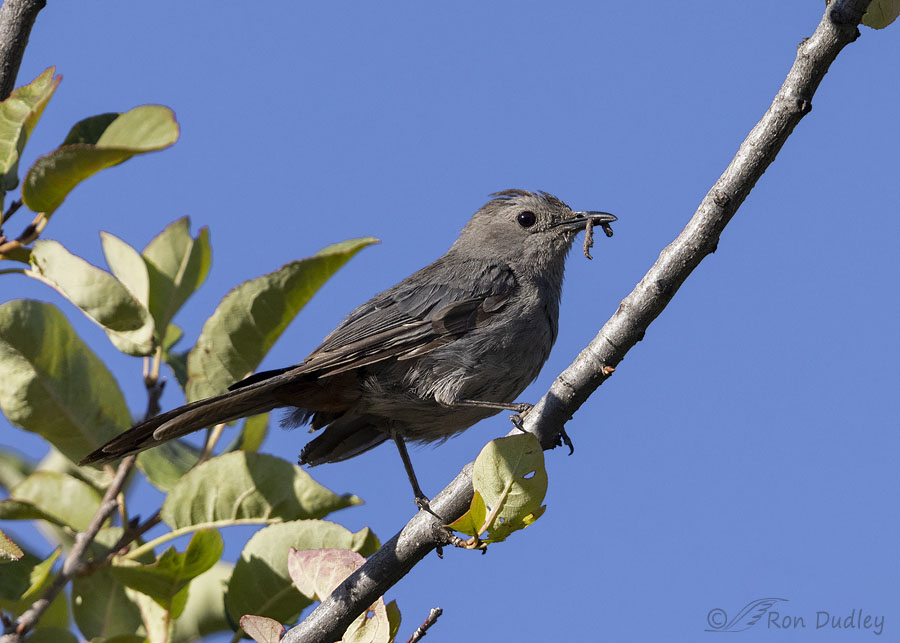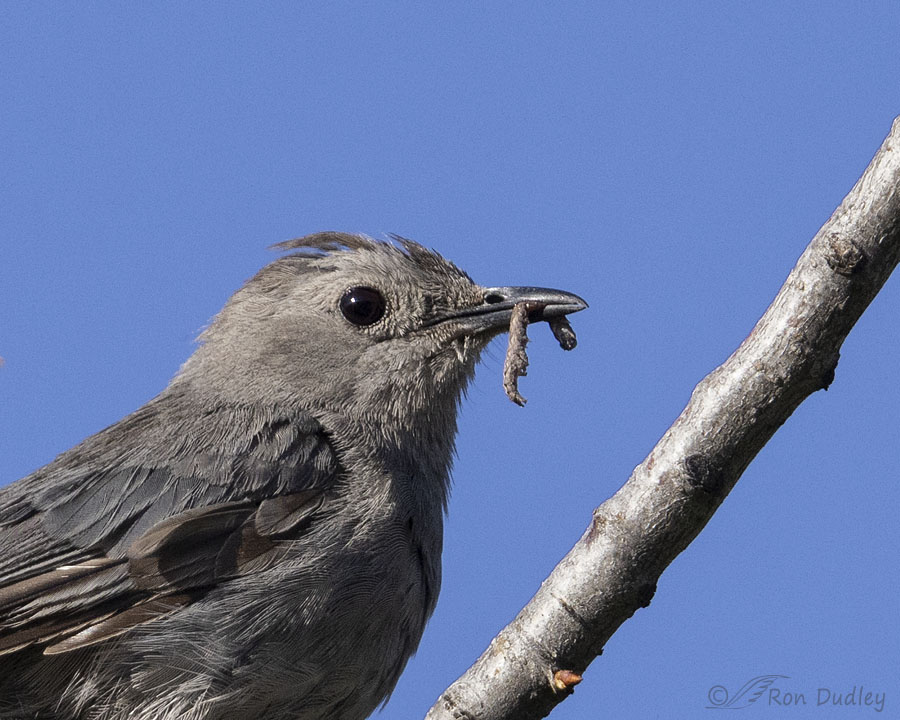Unidentified insect prey. I’d like to change that.

1/3200, f/5.6, ISO 1000, Canon EF500mm f/4L IS II USM + 1.4 tc, not baited, set up or called in
Two days ago in the Wasatch Mountains I watched as this young Gray Catbird plunged into a cluster of willow leaves and emerged with an insect larva in ‘his’ bill. Then he held this pose for quite a while, as if he was trying to decide what to do with it.. Eventually he took off with it still in his bill but he took off away from me so I struck out with the takeoff shot I was after.
While processing the photo I became curious about the insect.

It has a rather unusual shape on one end, enough so that I thought it might be distinctive enough for some of my readers who are more entomology inclined than I am to identify it. When I enlarge the image even more than this, the insect’s anterior end appears to be on the far side of the bird’s bill and it looks to me like there are two tiny curved ‘claws’ at the posterior end. And then there’s that strange swelling near the posterior end.
If anyone out there can come even close to a a positive ID of the insect I’d appreciate knowing your thoughts. I have no clue and I’m curious.
Ron


You must have an entomologist friend out there who can help! That second closeup shot should be helpful. At my age I’ve forgotten most of what I learned, unless I use it every day! Wish I could have helped. Sorry!!!!!
No clue as to the insect ID, but am enjoying the catbird in its “seat.” 😉 He looks a little scruffy, so that insect might not have been easy prey. Love being able to see the detail in the big crop.
Hooray. I can get into your site today. Fingers crossed I retain that access. I am completely clueless about the insect though.
And delight in the beautiful bird.
Glad you could come aboard today, EC. Hopefully the suggestion I sent you will fix the issues you’ve been having.
Science class in session! And down the rabbit hole we go – Stick caterpillar/pepper moth/Geometridae – a whole day’s learning ahead, thanks to a little grey catbird grabbing breakfast and then posing for the master photographer/teacher. Thank you!
Rabbit hole indeed, Carolyn! I’m afraid I didn’t teach much of anything today. Mostly I’m trying to learn from some of my more learned readers.
I’m with Everett, far from being any sort of entomologist. So I’ll simply note that he’s a cute little Catbird, even with food hanging out of his beak!
Glad you like the bird, Chris. Thanks.
Bird is cute. Bug? Not so much. Eat, bird. Eat!!!!
I’m sure he did, Arwen. Eventually.
I’d go for some kind of Geometridae moth, too, though one of my insect guides says there are 1,450 species in North America. Now, if I could only find my 12 volume inch moth ID guide.
Nice detail in the second photo. I always like a good look at the eye ring. Curious dark area on the scapulars/coverts.
“1,450 species in North America”
Wow, I had no idea Lyle. That probably makes it unlikely that we’ll be able to narrow it down to species. But even to genus would pretty much satisfy my curiosity..
Another thought– looks a little like a lizard leg– especially the claws/toes.
I guess it does, Kris. But I think it’s an insect…
Nice glamour shot of a geometer moth inchworm that looks possible: https://pixels.com/featured/inchworm-geometer-moth-larvae-on-stem-of-leaf-reimar-gaertner.html
Maybe…
Excellent photos, but I am about the farthest from being an entomologist among your followers. Looks more like some kind of a worm rather than an insect, but have no idea. Looking forward to the responses.
Everett,,I wouldn’t completely rule out the possiblilty that it’s a worm. Worms don’t have legs and those tiny appendages behind the posterior ‘swelling” look like they could be setae (bristles) rather than true, jointed legs. I wish I’d been closer so I had more detail in the photo.
I have had several types of “songbirds” hold a bug in it’s beak while standing around, it seems that there is usually a nest and/or fledgling nearby that it wants to feed, but is waiting until it feels safe.
Bernard, but this is a young bird of the year.so it wouldn’t be nesting or feeding young.
Is it possibly an inchworm?
Ken, when one of my readers on FB suggested it might be a “caterpillar of a geometrid moth” I wondered the same thing because they do look a little like inchworms. However, most of them seem to have appendages on both ends instead of just one.
What an intriguing mystery– I’m gonna be checking your posse responses
all day, hoping someone will have an I.d…….interesting that he hasn’t
snarfed it down –maybe HE’S trying to figure it out, too…….
Kris, he held that pose for long enough I had to wonder if he was showing off his prize to me.
Nice shot of the catbird….. 🙂 NO idea on the insect ????
Thanks, Judy. One reader suggested “stick caterpillar”.
A Google search of stick caterpillar leads me to say, Bingo!
I did the same thing, Marcia. Could be.